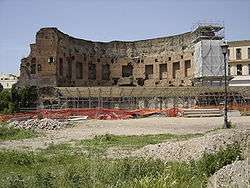Baths of Trajan

The Baths of Trajan were a massive thermae, a bathing and leisure complex, built in ancient Rome starting from 104 AD and dedicated during the Kalends of July in 109. Commissioned by Emperor Trajan, the complex of baths occupied space on the southern side of the Oppian Hill on the outskirts of what was then the main developed area of the city, although still inside the boundary of the Servian Wall. The architect of the complex is said to be Apollodorus of Damascus. The baths were being utilized mainly as a recreational and social center by Roman citizens, both men and women, as late as the early 5th century.[1] The complex seems to have been deserted soon afterwards as a cemetery dated to the 5th century (which remained in use until the 7th century) has been found in front of the northeastern exedra.[2] The baths were thus no longer in use at the time of the siege of Rome by the Goths in 537; with the destruction of the Roman aqueducts, all thermae were abandoned, as was the whole of the now-waterless Mons Oppius. Early Christian writers misnamed the remains the 'Baths of Domitian'.[3]
Location
Prior to the construction of the Baths, their location on the Oppian Hill was occupied by the ornate Palace of Nero (Domus Aurea). After Nero's suicide, subsequent emperors Vespasian, Titus, and Domitian chose to build over his palace with other forms of architecture. Emperor Trajan covered up the last of the palace with a platform upon which the Baths were built. Because they served as a model for bath complexes built throughout the Roman world during the Imperial period, these Baths would come to be recognized as a highly notable example of early Imperial Roman architecture.

The baths were erected on the Oppian Hill, a southern extension of the Esquiline Hill. Built on a platform that had itself been built over Nero's Palace, the bath complex was immense by ancient Roman standards, covering an area of approximately 330 by 215 meters. The complex rested on a northeast-southwest axis, with the main building attached to the northeast wall. This was contrary to the more widely used north-south axis of many buildings in the vicinity. It is suggested that this unorthodox orientation was chosen by the architects to reduce the bathers' exposure to the wind, while also maximizing exposure to the sun.
Within the complex, the building was surrounded by a large grassy area. The baths themselves consisted of pools, including a tepidarium (warm area and, it is presumed, first room visited in the baths), a caldarium (hot pool and dry, sauna-like area), frigidarium (cool pools used after those previously mentioned), and also gymnasia, and apodyteria (changing rooms). In addition to the facilities of the bath complex used by the public, there was a system of subterranean passageways and structures used by slaves and workers to service and maintain the facilities. Also underground, the massive cistern, surviving today as the Sette sale, the "seven rooms", stored much of the water used in the baths. It was capable of storing no less than 8 million liters. There were also several exedrae on the eastern and western sides of the building. After archaeological analysis performed after excavation in 1997, it is thought that at least one of these exedra served as a sort of library and a holding place for scrolls and manuscripts.
"City fresco" and mosaics
The archaeological excavations of 1997 also led to the discovery of a large (about 10 square meters) frescoed bird's-eye view of a walled port city, a unique survivor of such a subject, in a buried gallery or cryptoporticus beneath the baths, which predated their construction, but postdated Nero's Domus Aurea. Whether it represents the reorganization of an actual port or an idealized one remains an open question.[4]
Additionally, the discovery of a 10 m mosaic was announced in July 2011, with more still to be excavated, in what is believed to be a Musaeum, a place dedicated to the goddesses who inspire the creation of the arts, featuring a nymphaeum (fountain room). Components of the mosaic identified to date, include:
- Apollo, the Greek god of music, poetry, prophecy, light, and healing, and "Leader of the Muses"
- capitals and columns decorated with garland plants
- several muses.
Also discovered nearby, another mosaic shows grape harvesting scenes.[5]
See also
General overview
Other baths
Engineers
Other
- List of Roman domes (half-domes)
- History of Roman and Byzantine domes
Notes
- ↑ When Felix Campanianus, the city praefect, had statues erected in them (CIL , 1670, noted by La Rocca, Eugenio (2001). "The Newly Discovered City Fresco from Trajan's Baths, Rome". Imago Mundi (Imago Mundi) 53: 121–124. doi:10.1080/03085690108592942.
- ↑ F. Carboni, Scavi all'esedra Nord-orientale delle Terme di Traiano dans Bulletino della Commissione archeologica comunale di Roma, pp. 65-80.
- ↑ Vaughan Hart, Peter Hick, Palladio's Rome, page 206
- ↑ La Rocca 2001.
- ↑ Apollo Mosaic Found in Rome Tunnel, Rossella Lorenzi, 29 July 2011, discovery.com, accessed 21 September 2011
References
- Anderson, James C. Jr. (1985). "The Date of the Thermae Traiani and the Topography of the Oppius Mons". American Journal of Archaeology (Archaeological Institute of America) 89: 499–509. doi:10.2307/504364.
- Platner, S.B. (1911). The Topography and Monuments of Ancient Rome (2nd ed.). p. 454.
- Gates, Charles (2003). Ancient Cities: The Archaeology of Urban Life in the Ancient Near East and Egypt, Greece, and Rome. Routledge. p. 378.
External links
| Wikimedia Commons has media related to Baths of Traianus. |
- Baths of Trajan
- Thermae Traiani, article in Platner's Topographical Dictionary of Ancient Rome
Coordinates: 41°53′30.72″N 12°29′46.61″E / 41.8918667°N 12.4962806°E